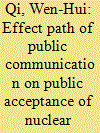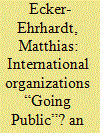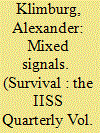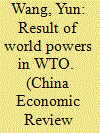|
|
|
Sort Order |
|
|
|
Items / Page
|
|
|
|
|
|
|
| Srl | Item |
| 1 |
ID:
176878


|
|
|
|
|
| Summary/Abstract |
Nuclear power plants in operation usually take public communication measures to increase the public acceptance of nuclear energy. This study explores how public communication affects public acceptance. The data were obtained through questionnaire surveys (N = 364) of residents living around the Qinshan, Tianwan, and Hongyanhe nuclear power plants in China. Based on the researches of mass communication effect path, a structural equation model showed that public communication cannot affect public acceptance directly, but can indirectly affect public acceptance through three paths. In the first path, public communication positively affects trust, trust positively affects perceived benefit, and perceived benefit positively affects public acceptance. In the second path, public communication positively affects trust, trust negatively affects perceived risk, and perceived risk negatively affects public acceptance. In the third path, public communication positively affects perceived benefit, and perceived benefit positively affects public acceptance. Furthermore, public communication has a positive effect on knowledge, but has no effect on public risk. This study also showed that knowledge cannot affect perceived risk and perceived benefit. We proposed policy suggestions based on the results.
|
|
|
|
|
|
|
|
|
|
|
|
|
|
|
|
| 2 |
ID:
163270


|
|
|
|
|
| Summary/Abstract |
The last few decades have seen a dramatic increase in the public communication efforts of international organizations (IOs). They target an expanding audience, including journalists, experts, activists, and citizens. Their communication departments have grown to more effectively produce and disseminate messages, evaluate their impact, and develop long-term communication strategies. I examine this trend for forty-eight IOs between 1950 and 2015. Based on an event history analysis of structural reforms, I argue that two causal mechanisms most consistently explain why IOs go public: First, normative change toward greater institutional transparency encourages the democratic membership of IOs to push for reforms in order to improve the provision of public information on IO decisions and policy programs. Second, public protest and scandals substantially increase organizational demands for self-legitimation. As a result, IOs reformed communication in order to more effectively generate public support. However, I find limited evidence that IO mandates to promote social change—by teaching norms and knowledge—can account for observed reforms to their communication structures.
|
|
|
|
|
|
|
|
|
|
|
|
|
|
|
|
| 3 |
ID:
170580


|
|
|
|
|
| Summary/Abstract |
Some risks of ‘persistent engagement’ could be mitigated by reducing its reliance on mixed signals and public communication.
|
|
|
|
|
|
|
|
|
|
|
|
|
|
|
|
| 4 |
ID:
124556


|
|
|
|
|
| Publication |
2013.
|
| Summary/Abstract |
Official reports and case studies reveal that China experienced different means of communication with the world powers since it joined the World Trade Organization in 2001. In the first five years, China had public communication with both the United States and the European Union under the Transitional Review Mechanism. In 2006 a new means of communication, the China-US Strategic and Economic Dialogue, started to take effect. Reports show that the new mechanism has advanced the China-US relationship positively and productively. The difference between the two means of communication stimulates our study. We adopt a game theory model to examine the impact of different communication protocols on China's incentives to reveal information. We analyze a cheap-talk game between an informed agent and two uninformed principals who coordinate actions under two communication protocols: public and private communication. First, all equilibria under both means of communication are characterized. Information precision of the agent's equilibrium messages decreases with the principals' preference biases. Second, under private communication the agent communicates more informatively with one principal if she in effect reveals little information to the other. Under private communication there exists an informative equilibrium with asymmetric levels of information precision even when all equilibria under public communication are uninformative.
|
|
|
|
|
|
|
|
|
|
|
|
|
|
|
|
|
|
|
|
|